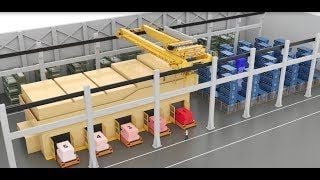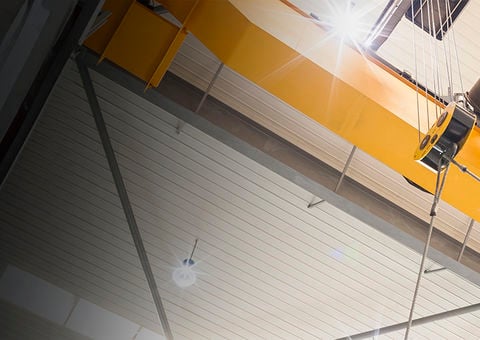WMS planning


Simulation models optimize planning
Using different simulation models, we analyze capacity and performance in order to provide recommendations on the system design and capacity, the number of bridge cranes and performance requirements as well as insight on the operational rules of the system.
Why simulation?
- The model provides a detailed view of the proposed system to make sure it meets your specified KPIs. It’s also used for throughput calculations, i.e., what would it look like if we added a second crane on a runway.
- Simulation modelling with 3D animation helps validate the design in terms of crane behavior, stacking height and operational rules.
- The model is also used to optimize die storage strategies and capacity, mobile robot/conveyor routes and material logistics within the facility.


Digital twin for insights and training
We use cutting-edge simulation technology to create a digital twin of your crane-automated press die warehouse that emulates the crane movements. This virtual model helps operators and engineers gain valuable early insights into the expected performance of the entire system.
Why a crane emulator?
- Can help identify potential bottlenecks, optimize storage configurations, and fine-tune operational procedures even before the physical warehouse is constructed.
- Can be used as a training tool for operators, letting them get familiar with the WMS and crane automation functionalities during the engineering phase.
- Advanced training helps provide a smooth transition to real-world operations, reducing the learning curve and enhancing overall efficiency once the warehouse is operational.
WMS service


Preventive Maintenance Service
Protect your warehouse management system investment with the WMS Preventive Maintenance Service. The service provides support for the Konecranes WMS software during the operation of the system and includes regular inspection and minor adjustments to maximize availability and minimize the risk of downtime. When you require high-level technical expertise, you can take advantage of troubleshooting support during office hours.


WMS Remote Support
When time is critical WMS Remote Support provides quick response for troubleshooting issues that require high-level technical expertise. Minimize unplanned downtime with 24/7 access to our global network of WMS specialists supported by local Standby Service.
In controlled circumstances, and assisted by local Standby Service, a two-way on-line communication with the local WMS system and their operators can be established to expedite corrective action.


 The Konecranes WMS Material Flow Module (MFM) controls the material flow of the dies outside the die storage area on the press bolster positions as well as on teaching positions or die transfer carts.
The Konecranes WMS Material Flow Module (MFM) controls the material flow of the dies outside the die storage area on the press bolster positions as well as on teaching positions or die transfer carts. Konecranes WMS Smart Features (SF) are designed for streamlining daily operations, providing operators with support, and minimizing the risk of errors. Smart technology and an intuitive interface make Smart Features an ideal solution for efficient and reliable die storage management.
Konecranes WMS Smart Features (SF) are designed for streamlining daily operations, providing operators with support, and minimizing the risk of errors. Smart technology and an intuitive interface make Smart Features an ideal solution for efficient and reliable die storage management. The Konecranes WMS Production Management Module (PMM) extends the WMS using a specially designed production optimization algorithm to determine the most efficient die exchange sequences.
The Konecranes WMS Production Management Module (PMM) extends the WMS using a specially designed production optimization algorithm to determine the most efficient die exchange sequences.


